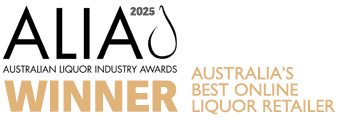2.7 Yeasts & Primary Fermentation
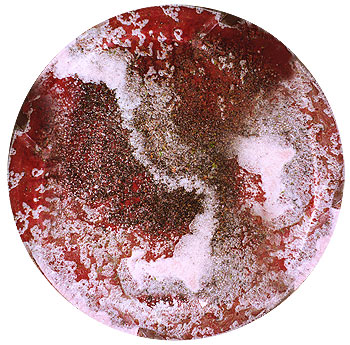 |
| Above: Looking down into a vat of fermenting Heathcote Shiraz. We may consider ourselves winemakers, however, the unseen engine behind wine fermentations are yeasts & their enzymes. Wine is essentially the result of competition between such microbes, a process which we have learnt to control in order to produce predictable results. Below yeast cells are pictured magnified and at various stages of 'budding'. |
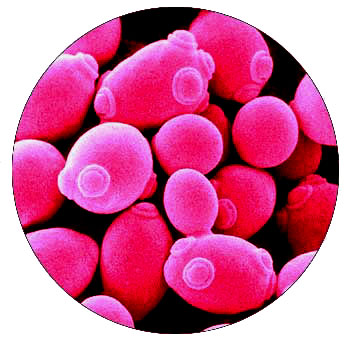 |
When we look down into a vat of fermenting wine, we're witnessing one of the first bio-chemical reactions observed by humans - a wild, bubbling and foaming, exothermic mass that seems closely akin to boiling,(the word is derived from the Latin 'fervere' meaning "to boil").For early peoples it was a miracle - Egyptians praised Osiris for the brewing of beer and the Greeks believed Dionysius was in charge of the fermentation atop Mount Olympus. As late as 1850, the European vigneron knew little better. Fermentation was subject to local conditions (yeast populations) which would infect beer or wine spontaneously, often with unpredictable or undesirable results. The cause of the mysterious transformations were traced to the foam of newly made beer or wine which could be passed on from batch to batch and proved similarly effective in leavening bread. *
The first insights into the precise mechanism of fermentation were repeatedly undermined by 19th century arguments over the concept of 'vitalism', the theory that the origin and phenomena of life are dependent on a force or principle distinct from purely chemical or physical forces. Fermentation was considered to be simply a chemical reaction and yeast (which was not yet even classified as a definite substance, much less a living organism) was thought to play a physical rather than a chemical role, "...it was held that either the catalytic action at the yeast cell or the molecular vibrations from the decomposing organic matter arising from the death of the cells, sparked the chemical changes resulting in fermentation."(1)
In a word, fermentation was considered akin to putrefaction.
The living nature of yeasts emerged during 1837 and 1838 when three publications appeared by C. Cagniard de la Tour, Theodor A. H. Schwann and F. Kuetzing. Each had independently observed yeasts through the microscope, multiplying by 'splitting in two', and each had concluded that yeast was a living micro-organism that reproduced by 'budding' (i.e.-, via an outgrowth that separates to form a new organism without sexual reproduction taking place). However, the scientific establishment of the time ridiculed suggestions that such organisms might be responsible for the world's great wines. Europe's preeminent organic chemist, Friedrich Wohler, anonymously attacked the partisans of the theory in an influential review of the time (the Annalen der Pharmacie) - Wohler reported that he had seen 'wine animals' through the microscope and offered a disparaging parody of his contemporaries observations:
The controversy was finally brought to a conclusion by the great French chemist Louis Pasteur (1822-1895). During the 1850s and 1860s, he conducted a series of classic investigations, which while not conclusive, strongly suggested that fermentation was initiated by living organisms:
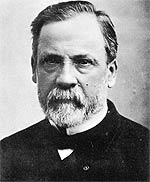 |
| Louis Pasteur (1822-1895) |
In 1877, working to improve the French brewing industry, Pasteur published his famous paper on fermentation, 'Etudes sur la Biere', (translated into English in 1879 as 'Studies on Fermentation'). He defined fermentation (incorrectly) as"life without air, "but correctly showed specific types of microorganisms cause specific types of fermentations and specific end products. We know now that these microorganisms are yeasts - a group of about 160 species of single celled, microscopic fungi that reproduce asexually. They exist nearly everywhere. Not all are useful. Some cause the spoilage of sugar rich foods, others cause disease.
However, many of Pasteur's contemporaries remained unconvinced. Influential German chemist, J. von Liebig conceded there were similarities between fermentation, putrefaction, and infectious diseases, but refused to believe that living organisms were the main causative agents. Throughout history, the truth has often been found between two extremes. So it was in this case - "... with the discovery of enzymes - complex organic catalysts produced by microorganisms such as moulds, yeasts, or bacteria - [it became apparent] that Pasteur was not entirely right, nor Liebig entirely wrong".(3)
As late as the early 1900's no one knew exactly what enzymes were or how they acted, but our understanding of them was to solve the fundamental mystery of fermentation. A detailed elucidation has taken scientists years of study. It is ongoing and still yielding surprising results.
Cultured Yeasts
Not all yeasts are suitable for the fermentation of wine. Most of the commercially significant yeasts used in making alcoholic drinks today are 'cultured yeasts' for which the wine industry have the brewers to thank. ** All yeast was wild once. Most of the cultured yeasts in use today have been isolated and passed on from "good" ferments somewhere in the world, thus there are 'Champagne isolates', 'Burgundy isolates', etc. Cultured yeasts consist of only one strain of yeast, do not contain mould, bacteria or other yeasts and have been optimised for a predictable outcome, though they may vary in their nitrogen and micro nutrient requirements and contribution to wine flavour. They're purchased in freeze dried form and vacuum packed. The winemaker re-hydrates the yeast in warm water bringing them out of their state of suspended animation. The hydrated yeast is then added to the freshly crushed juice, usually at around 5 billion cells / litre (ratios which guarantee a strong start to the ferment and a clockwork finish). Members of the genusSaccharomyces, or"sugar fungi"especiallySaccharomyces cerevisiaeof which there are more than 1,700 catalogued strains, andSaccharomyces bayanus, are the most commonly used cultured yeasts in the wine industry due to the unique qualities they possess:
2. They can quickly establish a viable population in an environment of high sugar (190-270 grams per litre) and high acidity; they ferment quickly, overwhelming and preventing other spoilage yeasts getting going first, only stopping when all the grape sugars have been utilised - else we'd be drinking sweet, low alcohol wines.
3. In conditions where most microbes would die, cultured yeasts are alcohol tolerant. That is, they can continue to ferment sugars to alcohol even during the latter stages of fermentation when the sugar is low but the alcohol content is high. (Most yeasts can't ferment much more than 4% alc. Very, very few can ferment to 13.5-14% alc. And even less can go to the 16%+ alc. So you want yeast that can ferment all the sugar. Even a little residual sugar can make food for spoilage bacteria).
4. Cultured yeasts are strong and consistent fermenters even at cold temperatures.
5. They don't produce unmanageable amounts of foam during ferment.
6. Vinegar, rotten egg gas, and sulphur dioxide are all yeast by-products and certain strains produce large amounts. Cultured yeasts produce desirable 'wine like' aroma and flavour characteristics (depending on the strain) while strong odours or noxious substances are released, if at all, in only very small amounts. (4)
Wild Yeasts
A less interventionist approach to inoculation is to let nature take its course. Wild yeast populations are present in the air around established vineyards and in wineries so that, left alone a grape that ripened until its skin split could potentially have its juice ferment. Such yeasts are variously known as 'indigenous' or 'ambient' - from herein we'll refer to them as 'wild yeasts'. In new wine regions, populations of wild yeasts take time to build up to levels that will be powerful enough to ferment grapes efficiently in the winery. "This means that many winemakers in areas new to wine have no choice but to import yeasts from elsewhere, at least in the beginning. Similarly, at the beginning of harvest, when the first grapes come into the winery, the yeast population is at its feeblest and may need encouragement." (5)
As the harvested fruit begins to arrive into the winery, fermentation typically begins slowly due to the naturally lower numbers of yeast cells present. Dividing from a small initial cell base means a wait of 3-4 days is not unusual before fermentation begins. When this occurs it is variously referred to as a 'natural', 'indigenous', 'wild' or 'spontaneous' fermentation.(6)As fermentation progresses, yeasts are literally everywhere, filling the air and covering clothes and equipment. According to Linda Bison, professor of viticulture and enology at the University of California, Davis, "...genetic testing indicates that from five to thirty different strains of yeast play a part in any given native fermentation. Some strains are active concurrently, while others might only shift into gear when another strain loses momentum. As the nutrient, temperature and alcohol levels vary in the must, different strains fall into and out of their metabolic sweet spots." (7)
Consequently, when wild yeasts are used it is unknown which strain will reproduce fastest so the sensory impact on the finished wine is left to chance. What's more, the wild yeasts that begin the fermentation are not necessarily the yeasts that finish it,"...in fact, nearly all fermentations of dry wines are completed by a species rarely found in vineyards, Saccharomyces cerevisiae... [which once used] establish residence in wineries and can survive for years. So while many producers embrace the romantic notion that native vineyard yeasts take wines dry, it's the yeasts in the fermentation facility that to the heavy lifting."(8)
Warrabilla winemaker Andrew Sutherland Smith agrees, "Often if you look at what actually does the fermenting it's the natural yeast found in the winery and on the grapes. For a lot of wineries that is a pretty conventional yeast that has been used in the winery previously (which is why there is heaps of it around). Many wild yeast ferments are relatively heavily sulphited with added SO2 to knock out the nasty yeasts that you don't want and there are plenty you don't want! There aren't that many [wild] yeasts that can cope with these conditions, especially if there is plenty of either natural or added acid in the grapes".
Wine's labeled as'Wild Ferment'may conjure up evocative imagery, but the title can be slightly misleading. Traditionally, wild yeasts and natural ferments have been more commonly accepted and used in Old World wine regions. Once a winery begins to use wild yeasts for each vintage, returning the pomace (the residue of grapes after being crushed) and lees (dead yeast cells) to the vineyard's soils helps to stabilize a sufficient yeast population suitable for reliable ferments. However, "Even those winemakers most determined to rely only on ambient yeasts tend to keep a small culture of them in a refrigerator from one year to the next so that they can add a starter culture to get the first fermentation going".(9)
Describing the Primary Fermentation of Wine
The sensory impact various yeasts contribute to wine flavour remains a subject of debate. (We'll discuss the pros and cons of wild vs. cultured strains below). Regardless of a winemaker's preference, the same basic mechanisms are activated during a wine's primary fermentation. Nowadays, the process of fermentation is generally reduced to a simple text book formula:
That is, when yeast comes into contact with grape juice, it begins to feed on sugars in the juice (fructose and glucose) and these are converted into alcohol by the yeast. Other byproducts of fermentation are aromas, flavours, carbon dioxide gas, and heat. This is greatly oversimplifying the matter.
Fermentation is more accurately defined as the chemical transformation of organic substances into simpler compounds by the action of yeast enzymes. Enzymes act by hydrolysis, a process of breaking down or predigesting complex organic molecules to form smaller (and in the case of foods, more easily digestible) compounds and nutrients. (For example, the enzyme protease[all enzyme names have the suffix 'ase']breaks down huge protein molecules first into polypeptides and peptides, then into numerous amino acids, which are readily assimilated by the body). In the case of wine, the enzyme 'zymase' within yeast converts the sugar in the grape juice into roughly equal parts of alcohol and carbon dioxide and releases energy in the form of heat. The process follows the formula:
This chemical equation describes the net change during fermentation of one glucose molecule giving two alcohol and two carbon dioxide molecules. But even this simplifies what is a many-stage process of biochemical reactions. Essentially, yeast's internal enzymes follow of a number of complex chemical reactions (known as glycolosis) during which glucose is gradually oxidized into pyruvic acid. *** The next step is dependent on the amount of oxygen available: If oxygen is present in excess, as it is in the natural environment, the end result of the fermentation is carbon dioxide and water. In winemaking, the environment is modified and controlled by limiting oxygen supply so that acetaldehyde (ethanal) is firstly formed which is then converted to alcohol (ethanol). Importantly, the biochemical reactions converting one compound into another are not 100% efficient - residual compounds accumulate and these can contribute so called 'secondary aromas and flavours' to the juice including acetaldehyde, ethyl acetate, fusel oils and esters, the latter of which typically offer fruity characteristics to the finished wine. (The concentration and character of these yeast-derived secondary metabolites is strain dependent).(10)In either fermentation (aerobic - [with oxygen] or anearobic [without oxygen]), the energy released along the way in the form of adenosine triphosphate (ATP) is used by the yeast cells to grow and divide.(11)
A curious aside to all of this is that unlike most yeasts,Saccharomyces cerevisiae, (the yeast commonly used in winemaking), has evolved to produce alcohol (rather than energy) even when oxygen is plentiful. Given that it can yield far more energy per glucose molecule by using oxygen to respire, this behavior is baffling and counter-intuitive to survival. At first it would seem that by churning out alcohol, the yeast compromises its life. New research by John Aris of the University of Florida in Gainesville has revealed that in doing so, the yeast is actually gaining a strategic advantage over other organisms in its vicinity: "Ethanol [alcohol] is toxic to most microbes, so acquiring the ability to turn all the glucose available in a fruit into a sea of the stuff gave S. cerevisae's ancestors a big competitive advantage. 'It quickly converts the sugar into something it can use to defend its territory' says Aris. The yeast of course has evolved a high tolerance to alcohol. This strategy would be hugely costly in terms of the energy lost by forgoing aerobic respiration, were it not for ADH2."(12)- this is one of two enzymes givingS. cerevisaea unique dual ability. ADH1 performs the familiar role of converting acetaldehyde into alcohol while ADH2 does the opposite, it turns alcohol back into acetaldehyde.
"Unlike ADH1, though, ADH2 is produced only when sugar levels fall...Once all the sugar is gone, there's all this ethanol out there,"Aris says. The yeast's second trick is to take the ethanol and convert it to acetaldehyde which it then breaks down into oxygen to reclaim as much energy as possible."You could say it's delayed gratification," he adds. In short, S. cerevisae turns sugars into a poison that kills of any rivals, and then feasts on the poison. It's such a successful trick that some other yeasts have evolved a similar strategy, though S. cerevisae does it best."(13) In a very real sense then, wine is the result of competition between microbes.(14)
Thankfully, winemakers have learnt to prevent the latter part of S. cerevisae's (ADH2) activity by carefully controlling oxygen, so that the yeast can't feed on the alcohol it's produced. GivenS. cerevisae'sbehaviour it's clear why all wine fermentations must begin aerobically (the more oxygen the cells can get, the more they will multiply but the less alcohol they'll produce), then continue anaerobically (limiting the contact with air thereafter to ensure a ferment to dryness). Unfortunately, some microbes have now developed a tolerance for alcohol, making the addition of sulphur dioxide necessary in order to minimise the potential of unpleasant flavours or fermentations turning to vinegar. ****
| VIDEO: Fermentation. |
The temperature of wine's fermentation is also significant for yeast,"...at a simplistic level, it plays a role in the overall extraction of flavour, tannin and colour in wine because it is directly related to the speed (and consequently length) of fermentation. However, its effect on the quality of the finished wine is much more important and intricate than this as virtually every chemical reaction involved in fermentation is effected by temperature."(15) Considerations for 'ideal' red and white wine fermentation temperatures vary between winemakers. We'll discuss this subject in detail in later chapters regarding 'Making Red & White Wine", as well as what's often termed 'secondary fermentation', that being 'Malolactic fermentation' which involves the action of bacteria.
A typical dry, table wine's fermentation is completed when all the fermentable sugars have been converted to alcohol. Once the wine is deemed free of fermentable sugar (dry) it is cooled and the dead yeast cells (known as gross lees) are allowed to settle. Alternatively, fermentation can be stopped prematurely to make wines of varying degrees of sugar (See chapter 2.11 Making Fortified Wine).
A Note on Stuck Ferments
Arguably one of the worst things that can happen in a winery is a stuck ferment. This is a fermentation that ceases before all the available sugar in the juice has been converted to alcohol and carbon dioxide. Instead, the juice is left in a semi-sweet, low alcohol state, vulnerable to bacterial spoilage and oxidisation. The wine is unsaleable. It's a winemaker's worst nightmare that's estimated to cost the world wide wine industry billions of dollars every year.(16)Once the fermentation is stuck, it's extremely difficult to restart due to a chemical compound released by dying yeasts that inhibits the future growth of yeast cells in the tank. There are several potential causes of a stuck ferment including excessive temperatures killing off the yeast or nutrient deficient must (yeasts require nitrogen, potassium and vitamins to reproduce)"...even if the yeasts survive, yet struggle, [as in a sluggish ferment] the process can lead to the formation of off flavours, such as volatile acidity (vinegar) and stinky sulphur based compounds."(17)If necessary, nutrients can be added to the must, however the most common method of minimising the chances of a stuck ferment is to use a cultured yeast strain with a high alcohol and high temperature tolerance coupled with diligent control of the fermentation temperature.
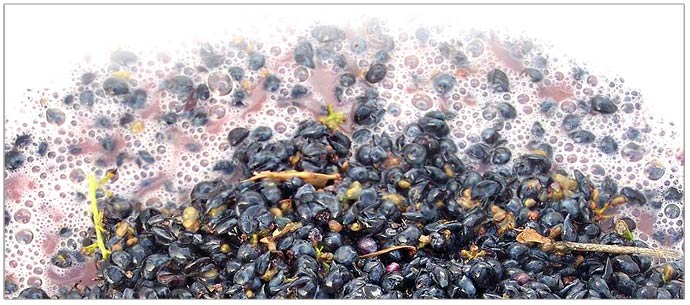
The Sensory Impact Debate: Wild vs Cultured Yeasts.
As has already been mentioned, besides creating alcohol, yeasts can contribute significantly to a wine's flavour and mouthfeel. Flavours and aromas can be adjusted through appropriate yeast strain selection so that winemakers can tailor a preferred style to a specific market demographic.(18)In a 2008 article in The Financial Times, UK wine writer Jancis Robinson articulated the crux of the yeast debate:"Like many observers of the wine scene I have been dimly aware of how the wines of the world are starting to taste much more similar, despite the fact that they come from a wider range of geographical sources than ever before. I strongly suspect that the widespread use of a relatively narrow range of commercial [cultured] yeasts has accentuated this phenomenon." (19)
Advocates of 'wild' fermentations believe that the risks they involve are justified because yeast populations native to their vineyards are an essential aspect of 'terroir' and enhance the individuality of the finished wine. Some believe that native yeasts can contribute superior mouthfeel, richer texture, a broader mid-palate and unusual aromas such as smoked venison and rose petals. Other winemakers steer a middle ground, separating the must into 10-12 vats and fermenting half 'spontaneously' and half using commercial yeast, then evaluating the performance of each vat before blending.
Proponents of cultured yeasts know these yeasts offer consistent sensory profiles making them powerful tools for producing specific or repeatable styles in their wines. The Lallemand company in the U.S., one of the major suppliers of cultured yeasts to the wine industry, has products listed on their online catalogue described in terms that would add confidence to the most inexperienced winemaker. Below are some examples of available cultures:
Enoferm Syrah: For classical Syrah aromas. Syrah is a Cote du Rhone isolate used for Syrah, Merlot and Carignane. It is a high glycerol producer and offers good mouthfeel and stable color extraction...Typical aromas include violets, raspberries, cassis, strawberries, black pepper and grilled meat.
Enoferm T306: For elegant aromatic whites. T306 was isolated from indigenous fermentations of Pinot Noir at Tyrrell's Vineyards, Pokolbin, in the Hunter Valley NSW Australia. It is used mainly for fruit focused Pinot gris, Chardonnay, Semillon and Chenin blanc for imparting aroma characters of exotic fruit and pineapple. In barrel fermented Chardonnay it contributes elegant white fruit and mouthfeel, particularly with lees contact time.
Enoferm VQ15: ...This new California isolate is used in concentrated reds, particularly Syrah, Zinfandel, Cabernet sauvignon and Merlot where a moderate fermentation rate is desired for rich, lush, balanced mouthfeel and full bodied wines. VQ15 has a moderate nitrogen demand and will allow good results with varietal flavor and red fruit and mineral aromatic note development when carefully rehydrated.... " (20)
And so on.
Whether the homogenisation of wine flavours due to the widespread use of such yeasts is a realistic concern or not remains difficult to ascertain. We put the question to several vignerons"Why is yeast selection so critical in the winemaking process? What influence can the type of yeast used have on the flavour and texture of a wine?"
Firstly, a response from Peter Gago, who has been responsible for some of Australia's most prestigious wines, including Penfold's Grange:
Then a voice of pragmatic indifference from across the Pacific, Chilean winemaker Sergio Cuadra of Eduardo Chadwick wines:
Perhaps the most compelling argument for cultured yeasts was a proverb of practicality from Tod Seghesio, winemaker at Sonoma Zinfandel specialist 'Seghesio Vineyards':
Australia seems to have its share of proponents for wild ferments. Corinna Rayment from Oliver's Taranga Vineyard in McLaren Vale is an unashamed enthusiast.
Troy Kalleske from Kalleske wines in the Barossa Valley shares this view.
Andrew Sutherland Smith from Warrabilla Wines in Rutherglen is open minded, but sceptical of the significance of the role yeasts play in wine flavour:
Regardless of winemaker's attitudes towards the influence of yeasts on wine flavour, it's clear that great wines have been and continue to be made with both wild yeastandcultured yeasts. Future developments in winemaking and wine styles appear destined to be tied in with our ongoing understanding of both. Australian scientists from the Australian Wine Research Institute are at the forefront. In 2008 they became the first in the world to decode all 6000 genes that make up the genome of a wine yeast. This means new strains of yeast can be developed without genetic engineering."To tailor-make your wine making process in such a way that you can shape your aroma profile, or the composition of your wine according to market specifications is absolutely critical, and the critical element in that process is the choice of yeast,"said Professor Sakkie Pretorius, the Institute's managing director."Use that information to develop strains that can adjust the alcohol levels, for example, to produce lower alcohol level of wine, or to produce better flavours and aromas according to certain market expectations."(22)The creation of 'designer wines' according to the tastes of niche markets and the potential for exotic new flavour profiles in traditional varietals may be the next major development the world's winemakers face. Whether the sensory effects of such yeasts will last for any length of time in the bottle is another matter. At present, it would seem that the use of cultured yeasts is intended to impart specific flavours in young wines, when they will be tasted, rated and sold. In other words, when it counts most.

- Micheal Ruhlman, The Elements of Cooking, Black Inc. 2008.
** "The technical innovation that made pure cultures practical, and with them real progress in microbiology, came in a Danish brewery. Emil Christian Hansen studied the anatomy of various mushroomlike fungi, and then fermentation, before receiving the Ph.D. at Copenhagen in 1878. That same year, he took a job at the Carlsberg brewery, soon became director of the laboratory, and continued at that post until his death in 1909. He learned that several yeasts and bacteria could infect beer and give it bad flavors, and began trying to purify cultures of the desirable yeasts. He eventually succeeded in growing cultures from single cells and maintaining them indefinitely in special flasks, and found that there were actually several alcohol producing yeasts, each with different characteristics. Hansen's expertise was first put to use in 1883. The original "Carlsberg Bottom Yeast I," which had been obtained in Munich in 1845, had spoiled. J. C. Jacobsen, the owner of Carlsberg allowed Hansen to run a large scale fermentation with one of the new pure cultures, and on November 12 the beer turned out to be excellent. Jacobsen generously refused to patent the culture process, and Hansen published his method. Soon most breweries in Europe and America were using cultured yeasts. Our food and drink could now be "seeded," with more predictable results than were possible by trusting to the air or to a starter from the previous batch." - On Food & Cooking, Harold Magee. Unwin Hyman, London 1984
*** It is interesting that this same series of steps in decomposition of sugar is employed in humans during muscular activity, another form of fermentation. In man, and other mammals, the three-carbon compound pyruvate is converted to lactic acid and supplies energy for muscular action. - The Oxford Companion to Wine. Oxford University Press, New York, 1984
**** The story doesn't end there. "To reduce the need for such preservatives, some researchers are now working to give yeast extra weapons to do this for themselves. Sakkie Pretorius of the Australian Wine Research Institute in Adelaide, for example, has added genes for microbe-killing proteins taken from the lactic acid bacteria in yogurt and chicken eggs."
- The brewer's tale. 23 December, 2006. Andy Coghlan writing for New Scientist Magazine Print Edition.
2. On Food & Cooking. The Science & Lore of the Kitchen. Harold Magee. Unwin Hyman, London 1984.
3. History of Soybeans and Soyfoods: 100 BC to the 1980's", unpublished manuscript by William Shurtleff & Akiko Aoyagi. 2007
4. Adapted from Richard Gawel, Primary Fermentation of Wine. www.aromadictionary.com with additional comments from Andrew Sutherland Smith, Warrabilla Wines, Rutherglen.
5. Forget the Grapes, It's a Cultural Thing. Jancis Robinson. The Financial Times, Sept 20th, 2008.
6. Richard Gawel, Primary Fermentation of Wine. www.aromadictionary.com
7. 'The Unseen Engine of Fermentation' by Daniel Sogg, Wine Spectator Magazine. October 15, 2006 Issue
8. Ibid.
9. Forget the Grapes, It's a Cultural Thing. Jancis Robinson. The Financial Times, Sept 20th, 2008.
10. Yeast Selection. Yeast contributes to Shiraz aroma & flavour. Walsh, Heinrich & Skurry. The Australian & New Zealand Wine Grower, October 2006. Citing Nykanen, 1986; Lambrechts and Pretorius, 2000
11. The Brewer's Tale. Andy Coghlan writing for New Scientist Magazine Print Edition. 23 December, 2006.
12. Ibid.
13. Ibid.
14. As Scientists at the University of Auckland have pointed out. Source: Yeast's Struggle to Survive Makes Wine, 5th August, University of Auckland. http://www.auckland.ac.nz
15. David Powell & Craig Isbel of Torbreck Wines in response to a Vintage School questionaire, www.torbreck.com
16. Lisa Van de Walter, microbiologist and Winemaking Consultant, as quoted in 'The Unseen Engine of Fermentation' by Daniel Sogg, Wine Spectator Magazine.
17. Ibid.
18. Yeast Selection. Yeast contributes to Shiraz aroma & flavour. Walsh, Heinrich & Skurry. The Australian & New Zealand Wine Grower, October 2006.
19. Forget the Grapes, It's a Cultural Thing. Jancis Robinson. Sept 20th, 2008. The Financial Times
20. http://www.lallemandwine.us
21. As quoted in 'The Unseen Engine of Fermentation' by Daniel Sogg, Wine Spectator Magazine. October 15, 2006 Issue
22. Australians map wine yeast code, ABC News October 2008. http://www.abc.net.au/news.
23. General information regarding fermentation sourced from The Oxford Companion to Wine. Oxford University Press, New York, 1984
24. The Elements of Cooking, Micheal Ruhlman, Black Inc. 2008.
